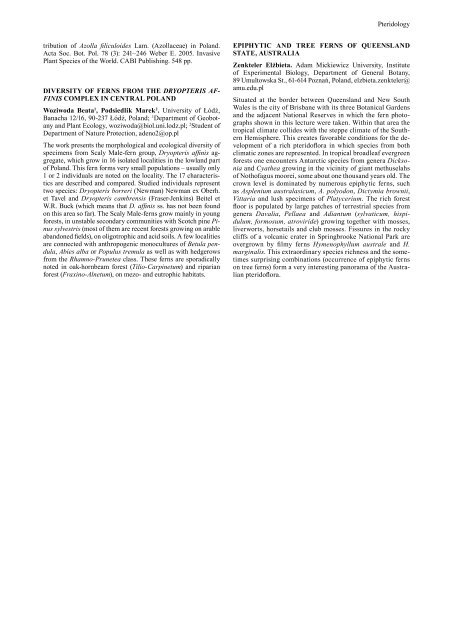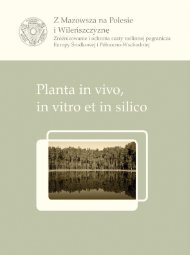acta societatis botanicorum poloniae - LV Zjazd Polskiego ...
acta societatis botanicorum poloniae - LV Zjazd Polskiego ...
acta societatis botanicorum poloniae - LV Zjazd Polskiego ...
Create successful ePaper yourself
Turn your PDF publications into a flip-book with our unique Google optimized e-Paper software.
tribution of Azolla filiculoides Lam. (Azollaceae) in Poland.<br />
Acta Soc. Bot. Pol. 78 (3): 241– 246 Weber E. 2005. Invasive<br />
Plant Species of the World. CABI Publishing. 548 pp.<br />
dIVErSITY OF FErNS FrOM THE dryoPteris Affinis<br />
COMPLEx IN CENTrAL POLANd<br />
Woziwoda Beata1 , Podsiedlik Marek2 . University of Łódź,<br />
Banacha 12/16, 90-237 Łódź, Poland; 1Department of Geobotany<br />
and Plant Ecology, woziwoda@biol.uni.lodz.pl; 2Student of<br />
Department of Nature Protection, adeno2@op.pl<br />
The work presents the morphological and ecological diversity of<br />
specimens from Scaly Male-fern group, Dryopteris affinis aggregate,<br />
which grow in 16 isolated localities in the lowland part<br />
of Poland. This fern forms very small populations – usually only<br />
1 or 2 individuals are noted on the locality. The 17 characteristics<br />
are described and compared. Studied individuals represent<br />
two species: Dryopteris borreri (Newman) Newman ex Oberh.<br />
et Tavel and Dryopteris cambrensis (Fraser-Jenkins) Beitel et<br />
W.R. Buck (which means that D. affinis ss. has not been found<br />
on this area so far). The Scaly Male-ferns grow mainly in young<br />
forests, in unstable secondary communities with Scotch pine Pinus<br />
sylvestris (most of them are recent forests growing on arable<br />
abandoned fields), on oligotrophic and acid soils. A few localities<br />
are connected with anthropogenic monocultures of Betula pendula,<br />
Abies alba or Populus tremula as well as with hedgerows<br />
from the Rhamno-Prunetea class. These ferns are sporadically<br />
noted in oak-hornbeam forest (Tilio-Carpinetum) and riparian<br />
forest (Fraxino-Alnetum), on mezo- and eutrophic habitats.<br />
Pteridology<br />
EPIPHYTIC ANd TrEE FErNS OF qUEENSLANd<br />
STATE, AUSTrALIA<br />
Zenkteler Elżbieta. Adam Mickiewicz University, Institute<br />
of Experimental Biology, Department of General Botany,<br />
89 Umultowska St., 61-614 Poznań, Poland, elzbieta.zenkteler@<br />
amu.edu.pl<br />
Situated at the border between Queensland and New South<br />
Wales is the city of Brisbane with its three Botanical Gardens<br />
and the adjacent National Reserves in which the fern photographs<br />
shown in this lecture were taken. Within that area the<br />
tropical climate collides with the steppe climate of the Southern<br />
Hemisphere. This creates favorable conditions for the development<br />
of a rich pteridoflora in which species from both<br />
climatic zones are represented. In tropical broadleaf evergreen<br />
forests one encounters Antarctic species from genera Dicksonia<br />
and Cyathea growing in the vicinity of giant methuselahs<br />
of Nothofagus moorei, some about one thousand years old. The<br />
crown level is dominated by numerous epiphytic ferns, such<br />
as Asplenium australasicum, A. polyodon, Dictymia brownii,<br />
Vittaria and lush specimens of Platycerium. The rich forest<br />
floor is populated by large patches of terrestrial species from<br />
genera Davalia, Pellaea and Adiantum (sylvaticum, hispidulum,<br />
formosum, atroviride) growing together with mosses,<br />
liverworts, horsetails and club mosses. Fissures in the rocky<br />
cliffs of a volcanic crater in Springbrooke National Park are<br />
overgrown by filmy ferns Hymenophyllum australe and H.<br />
marginalis. This extraordinary species richness and the sometimes<br />
surprising combinations (occurrence of epiphytic ferns<br />
on tree ferns) form a very interesting panorama of the Australian<br />
pteridoflora.



